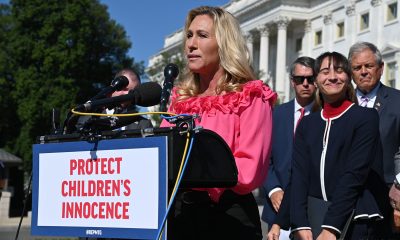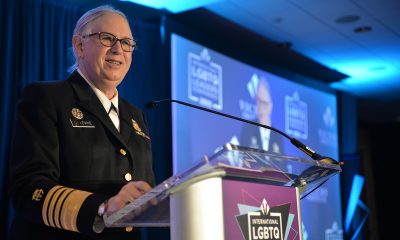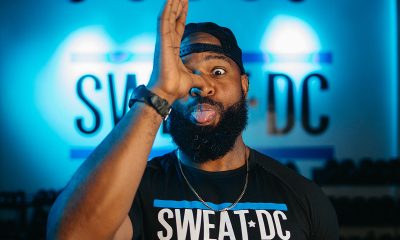Books
The friendship between a first lady and a ‘Firebrand’
Pauli Murray, Eleanor Roosevelt bonded during civil rights movement
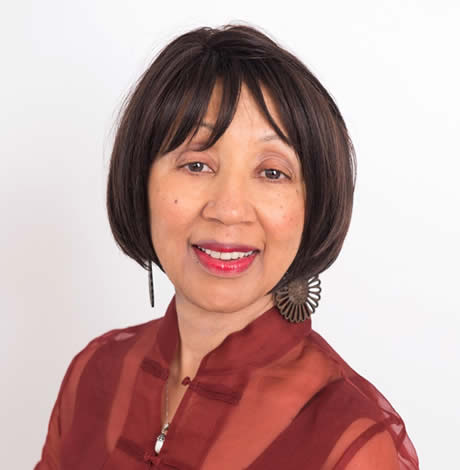
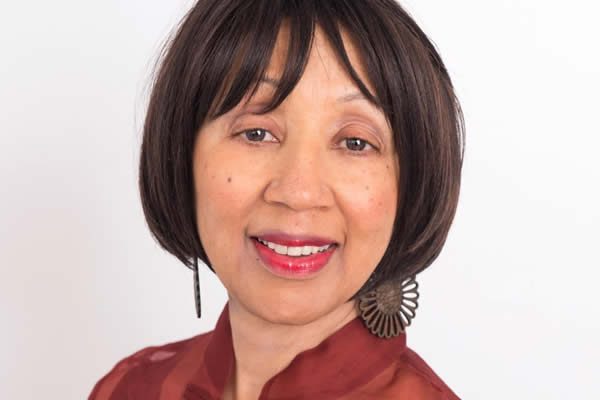
Patricia Bell-Scott explores the friendship between Eleanor Roosevelt and Pauli Murray in her new book.
Most of us would be proud to have earned a degree, written an acclaimed book of poetry or memoir, worked tirelessly for civil rights and have been part of a friendship that fostered human rights.
Pauli Murray, the groundbreaking African-American activist, lawyer, writer and priest, who lived from 1910-1985 and was attracted to women, did all this and much more. For nearly 25 years, Murray the granddaughter of a mixed-race slave, was a friend of Eleanor Roosevelt, whose privileged background entitled her to belong to the Daughters of the American Revolution. (Roosevelt resigned from the DAR in 1939 when the group prohibited the renowned African-American singer Marian Anderson from performing at Constitution Hall in Washington, D.C.)
In her compelling new book “The Firebrand and the First Lady: Portrait of a Friendship: Pauli Murray, Eleanor Roosevelt, and the Struggle for Social Justice,” Patricia Bell-Scott, editor of the anthology “All the Women Are White, All the Blacks Are Men, but Some of Us Are Brave,” tells the story of this extraordinary relationship. Bell-Scott is professor emerita of women’s studies and human development and family science at the University of Georgia. Her previous books include: “Life Notes: Personal Writings by Contemporary Black Women” and “Double Stitch: Black Women Write about Mothers and Daughters,” which won the Letitia Woods Brown Memorial Book Prize.
From 1938-1962, their friendship was sustained by some 300 postcards and letters as well as personal visits. The relationship began when Murray, 27, working for the WPA, a New Deal agency, sent Eleanor Roosevelt a letter protesting a speech Franklin Delano Roosevelt had made at the University of North Carolina. (The university had refused to admit Murray as a student because she was black.) The friendship continued until Roosevelt, 26 years older than Murray, died in 1962.
Murray earned three law degrees, organized sit-ins in the 1940s while a student at Howard University against eateries that discriminated against people of color, participated in bus boycotts 15 years before Rosa Parks and created the legal strategy that ensured that sex discrimination was included in the Civil Rights Act.
A co-founder of the National Organization for Women, Murray wrote the memoir “Proud Shoes,” the well-regarded poetry collection “Dark Testament” as well as numerous essays and books. In 1977, she became one of the first women to be ordained as a priest by the Episcopal Church. Though Murray hadn’t been involved in writing it, in 1971 Ruth Bader Ginsburg, in an homage to Murray’s work, listed her as a co-author in her first brief before the Supreme Court.
Born in Baltimore, Murray didn’t use her given name “Anna Pauline.” Her father was a teacher and her mother was a nurse. At age three, after her mother died, Murray went to Durham, N.C., where she lived with her grandparents and two of her aunts, one of whom became her adoptive mother. In her childhood, Murray’s father, after contracting what was thought to be encephalitis, suffered from “unpredictable attacks of depression and violent moods.” Murray wasn’t ashamed of her sexual orientation and was in a long-term relationship with Irene, “Renee” Barlow. Yet, because of homophobia and her race, she was often denied employment in the government and the private sector.
It’s no wonder that it took Bell-Scott 20 years to write “Firebrand.” Recently, she talked with the Blade about the book and the friendship between Murray and the woman, who Murray called “Mrs. R.”
“This was not something I intended to do,” Bell-Scott said of “Firebrand.” “I was working on another project at the time.”
Then in 1983, Bell-Scott asked Murray to serve as a consulting editor to “SAGE: A Scholarly Journal of Black Women,” of which she was a co-founding editor. Though Murray couldn’t do SAGE, she wrote a letter of “encouragement” to Bell-Scott. “Pauli wanted to work on her autobiography,” she said.
In a follow-up to this letter, Murray wrote to Bell-Scott, “You need to know some of the veterans of the battle whose shoulders you now stand on.”
She didn’t say, “know me better,” Bell-Scott said, “but she did say she took great pride in her work as a member of the subcommittee on legal rights of the President’s Commission on the Status of Women. (President John F. Kennedy appointed Eleanor Roosevelt chair of the commission.)
Bell-Scott made notes of what she wanted to talk about with Murray when her writing project was finished. “But I didn’t get the chance —18 months later, she died of pancreatic cancer,” she said. “Her letter haunted me. Quite a few years later, I decided I was still so haunted by her comment about knowing the veterans on whose shoulders you’re standing on.”
After examining the collection of Murray’s letters at the Schlesinger Library at Harvard University and the collection of Roosevelt’s letters at the Franklin D. Roosevelt Library, Bell-Scott said, she “immediately recognized that their relationship deserved attention.” Their friendship is mentioned only briefly by historians and biographers.
Despite the fact that Murray and Roosevelt came from very different backgrounds, they had a lot in common, Bell-Scott said. “To begin with, Anna was the given name for both of them and they never used it,” she said. “They both lost their parents before their teens and were sent to live with elderly kin.”
They were sensitive kids who grew up to be compassionate women with a thirst for justice, Bell-Scott said. “Even though she was first lady, people made fun of Eleanor’s appearance and ridiculed her teeth,” she added. “Pauli was boyish looking. People poked fun at how she looked.”
Murray and Roosevelt loved their fathers who suffered from mood disorders and alcoholism respectively. Though they were outspoken and highly energetic in their quest for social justice, “people were often surprised to learn that Pauli and Eleanor were both shy,” Bell-Scott said. “It took them tremendous psychic energy to overcome their shyness.”
Both were voracious readers and avid writers. Though she was a committed social justice activist, lawyer and priest, writing was what was closest to Murray’s heart, Bell-Scott said. “Pauli couldn’t turn away from activism,” she said, “but if there were any regrets – she would have liked to have written more.”
Roosevelt, too, was committed to her writing, Bell-Scott said. “Eleanor wrote her ‘My Day’ column even when she was first lady,” she said. “After FDR’s death, she reported on Russia and pursued other writing projects.”
Their sense of well being was dependent on having meaningful work and exercise, Bell-Scott said. “They had a talent for friendship. And they loved dogs. Eleanor liked Scotties and Pauli liked mutts and strays.”
Murray would work herself into exhaustion and crash, Bell-Scott said. “She suffered from mood swings which weren’t properly diagnosed as a thyroid disorder until Pauli was in her 40s,” she said. “Eleanor suffered episodes of depression.”
Their friendship was the context that allowed Murray and Roosevelt to grow into the “transformative leaders that we know them as,” Bell-Scott said. “When they first met, Pauli was an impatient young radical … Eleanor felt it was important to always consider taking social justice action with great caution – to always follow the muted action on civil rights of the Roosevelt administration.” (FDR never publicly pushed Congress to speak out against lynching, Bell-Scott said.)
Later in their lives, Bell-Scott said, Murray had moved from radical left to left of center – voting for Lyndon Johnson as a registered Democrat after decades of voting for Socialist candidates. By the 1960s, Roosevelt had put her life on the line at civil rights workshops and demonstrations.
“When I look at the issue of Pauli’s sexuality, I think of the social context of the time. Here is a woman coming to adulthood in the 1920s, 30s and 40s,” she said. “Homosexuality is defined as a mental disorder until the 1970s. Pauli, a very bright woman, reads the scientific literature.”
Added to this, Bell-Scott said, was the homophobia of McCarthyism, which considered LGBT people to be a security threat. “Pauli was a black woman lawyer,” she said, “ that’s an unconventional career for a woman. There are rumors about her sexuality and her mental health. She is living with discrimination on so many fronts.”
But Murray wasn’t ashamed of who she was, Bell-Scott said. “She was raised as a child by elder kin with Victorian values. You didn’t talk about sexuality.”
From reading Murray’s letters and sermons from later in her life, “it seems to me that Pauli began to publicly embrace herself,” Bell-Scott said.
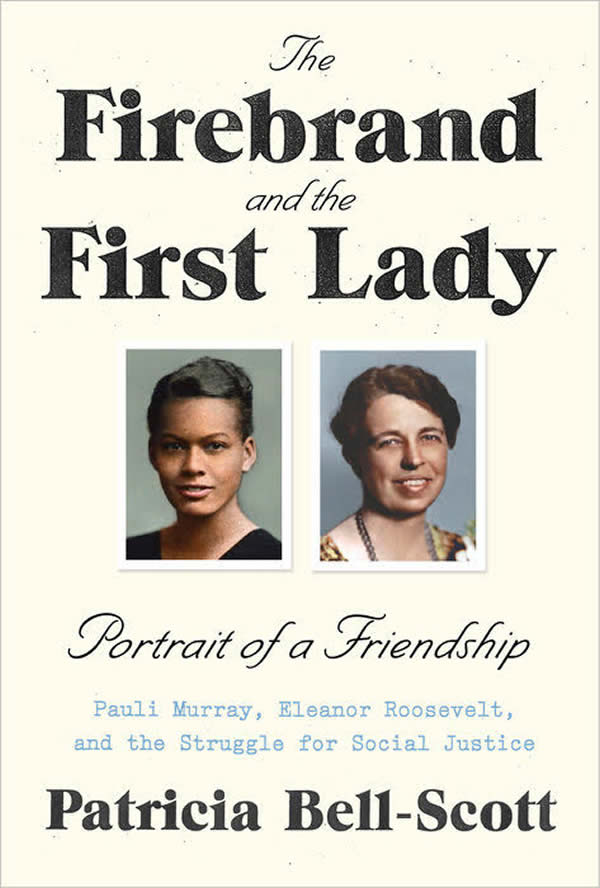
Books
This gay author sees dead people
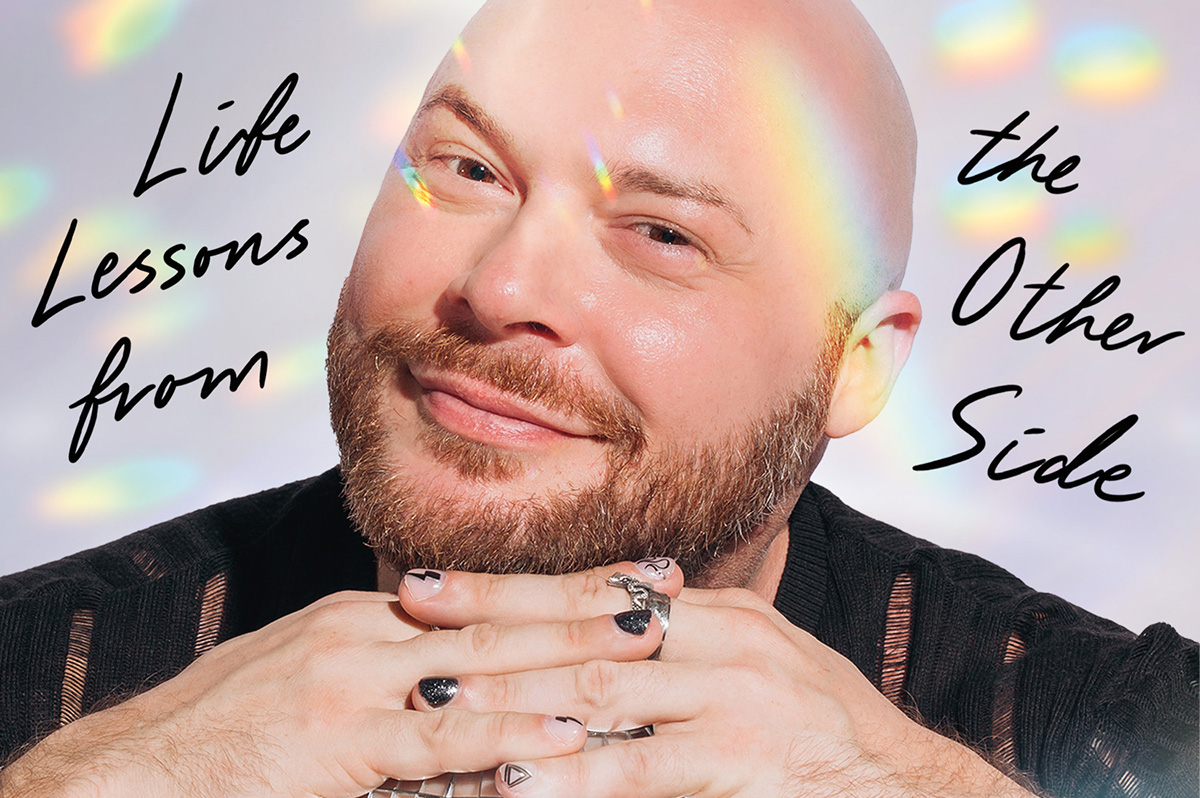
‘Are You There Spirit? It’s Me, Travis’
By Travis Holp
c.2025, Spiegel and Grau
$28/240 pages
Your dad sent you a penny the other day, minted in his birth year.
They say pennies from heaven are a sign of some sort, and that makes sense: You’ve been thinking about him a lot lately. Some might scoff, but the idea that a lost loved one is trying to tell you he’s OK is comforting. So read the new book, “Are You There, Spirit? It’s Me, Travis” by Travis Holp, and keep your eyes open.

Ever since he was a young boy growing up just outside Dayton, Ohio, Travis Holp wanted to be a writer. He also wanted to say that he was gay but his conservative parents believed his gayness was some sort of phase. That, and bullying made him hide who he was.
He also had to hide his nascent ability to communicate with people who had died, through an entity he calls “Spirit.” Eventually, though it left him with psychological scars and a drinking problem he’s since overcome, Holp was finally able to talk about his gayness and reveal his otherworldly ability.
Getting some people to believe that he speaks to the dead is still a tall order. Spirit helps naysayers, as well as Holp himself.
Spirit, he says, isn’t a person or an essence; Spirit is love. Spirit is a conduit of healing and energy, speaking through Holp in symbolic messages, feelings, and through synchronistic events. For example, Holp says coincidences are not coincidental; they’re ways for loved ones to convey messages of healing and energy.
To tap into your own healing Spirit, Holp says to trust yourself when you think you’ve received a healing message. Ignore your ego, but listen to your inner voice. Remember that Spirit won’t work on any fixed timeline, and its only purpose is to exist.
And keep in mind that “anything is possible because you are an unlimited being.”
You’re going to want very much to like “Are You There, Spirit? It’s Me, Travis.” The cover photo of author Travis Holp will make you smile. Alas, what you’ll find in here is hard to read, not due to content but for lack of focus.
What’s inside this book is scattered and repetitious. Love, energy, healing, faith, and fear are words that are used often – so often, in fact, that many pages feel like they’ve been recycled, or like you’ve entered a time warp that moves you backward, page-wise. Yes, there are uplifting accounts of readings that Holp has done with clients here, and they’re exciting but there are too few of them. When you find them, you’ll love them. They may make you cry. They’re exactly what you need, if you grieve. Just not enough.
This isn’t a terrible book, but its audience might be narrow. It absolutely needs more stories, less sentiment; more tales, less transcendence and if that’s your aim, go elsewhere. But if your soul cries for comfort after loss, “Are You There, Spirit? It’s Me, Travis” might still make sense.
The Blade may receive commissions from qualifying purchases made via this post.
Books
‘Dogs of Venice’ looks at love lost and rediscovered
A solo holiday trip to Italy takes unexpected turn
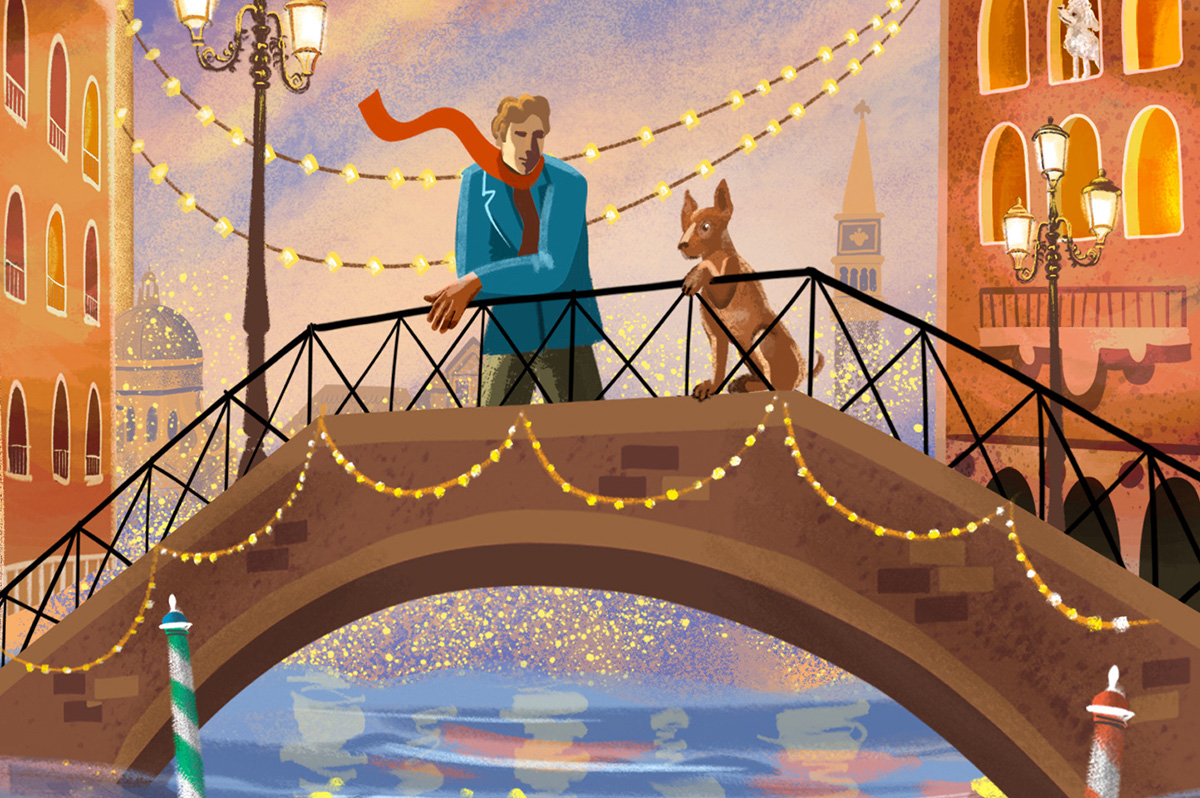
‘The Dogs of Venice’
By Steven Crowley
c.2025, G.P. Putnam & Sons
$20/65 pages
One person.
Two, 12, 20, you can still feel alone in a crowded room if it’s a place you don’t want to be. People say, though, that that’s no way to do the holidays; you’re supposed to Make Merry, even when your heart’s not in it. You’re supposed to feel happy, no matter what – even when, as in “The Dogs of Venice” by Steven Rowley, the Christmas tinsel seems tarnished.

Right up until the plane door closed, Paul held hope that Darren would decide to come on the vacation they’d planned for and saved for, for months.
Alas, Darren was a no-show, which was not really a surprise. Three weeks before the departure, he’d announced that their marriage wasn’t working for him anymore, and that he wanted a divorce. Paul had said he was going on the vacation anyhow. Why waste a perfectly good flight, or an already-booked B&B? He was going to Venice.
Darren just rolled his eyes.
Was that a metaphor for their entire marriage? Darren had always accused Paul of wanting too much. He indicated now that he felt stifled. Still, Darren’s unhappiness hit Paul broadside and so there was Paul, alone in a romantic Italian city, fighting with an espresso machine in a loft owned by someone who looked like a frozen-food spokeswoman.
He couldn’t speak or understand Italian very well. He didn’t know his way around, and he got lost often. But he felt anchored by a dog.
The dog – he liked to call it his dog – was a random stray, like so many others wandering around Venice unleashed, but this dog’s confidence and insouciant manner inspired Paul. If a dog could be like that, well, why couldn’t he?
He knew he wasn’t unlovable but solo holidays stunk and he hated his situation. Maybe the dog had a lesson to teach him: could you live a wonderful life without someone to watch out for, pet, and care for you?
Pick up “The Dogs of Venice,” and you might think to yourself that it won’t take long to read. At under 100 pages, you’d be right – which just gives you time to turn around and read it again. Because you’ll want to.
In the same way that you poke your tongue at a sore tooth, author Steven Rowley makes you want to remember what it’s like to be the victim of a dead romance. You can do it here safely because you simply know that Paul is too nice for it to last too long. No spoilers, though, except to say that this novel is about love – gone, resurrected, misdirected – and it unfolds in exactly the way you hope it will. All in a neat evening’s worth of reading. Perfect.
One thing to note: the Christmas setting is incidental and could just as well be any season, which means that this book is timely, no matter when you want it. So grab “The Dogs of Venice,” enjoy it twice with your book group, with your love, or read it alone.
The Blade may receive commissions from qualifying purchases made via this post.
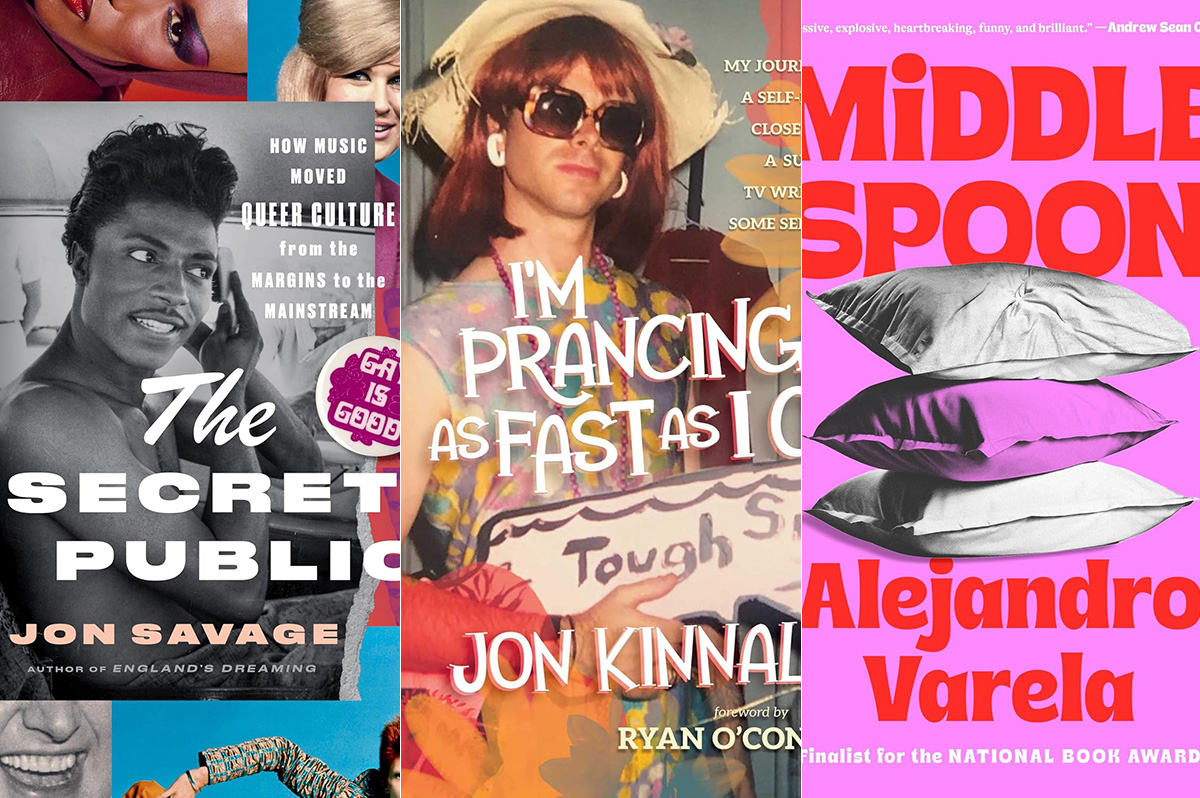
Santa will be very relieved.
You’ve taken most of the burden off him by making a list and checking it twice on his behalf. The gift-buying in your house is almost done – except for those few people who are just so darn hard to buy for. So what do you give to the person who has (almost) everything? You give them a good book, like maybe one of these.
Memoir and biography
The person who loves digging into a multi-level memoir will be happy unwrapping “Blessings and Disasters: A Story of Alabama” by Alexis Okeowo (Henry Holt). It’s a memoir about growing up Black in what was once practically ground zero for the Confederacy. It’s about inequality, it busts stereotypes, and yet it still oozes love of place. You can’t go wrong if you wrap it up with “Queen Mother: Black Nationalism, Reparations, and the Untold Story of Audley Moore” by Ashley D. Farmer (Pantheon). It’s a chunky book with a memoir with meaning and plenty of thought.
For the giftee on your list who loves to laugh, wrap up “In My Remaining Years” by Jean Grae (Flatiron Books). It’s part memoir, part comedy, a look back at the late-last-century, part how-did-you-get-to-middle-age-already? and all fun. Wrap it up with “Here We Go: Lessons for Living Fearlessly from Two Traveling Nanas” by Eleanor Hamby and Dr. Sandra Hazellip with Elisa Petrini (Viking). It’s about the adventures of two 80-something best friends who seize life by the horns – something your giftee should do, too.
If there’ll be someone at your holiday table who’s finally coming home this year, wrap up “How I Found Myself in the Midwest” by Steve Grove (Simon & Schuster). It’s the story of a Silicon Valley worker who gives up his job and moves with his family to Minnesota, which was once home to him. That was around the time the pandemic hit, George Floyd was murdered, and life in general had been thrown into chaos. How does someone reconcile what was with what is now? Pair it with “Homestand: Small Town Baseball and the Fight for the Soul of America” by Will Bardenwerper (Doubleday). It’s set in New York and but isn’t that small-town feel universal, no matter where it comes from?
Won’t the adventurer on your list be happy when they unwrap “I Live Underwater” by Max Gene Nohl (University of Wisconsin Press)? They will, when they realize that this book is by a former deep-sea diver, treasure hunter, and all-around daredevil who changed the way we look for things under water. Nohl died more than 60 years ago, but his never-before-published memoir is fresh and relevant and will be a fun read for the right person.
If celeb bios are your giftee’s thing, then look for “The Luckiest” by Kelly Cervantes (BenBella Books). It’s the Midwest-to-New-York-City story of an actress and her life, her marriage, and what she did when tragedy hit. Filled with grace, it’s a winner.
Your music lover won’t want to open any other gifts if you give “Only God Can Judge Me: The Many Lives of Tupac Shakur” by Jeff Pearlman (Mariner Books). It’s the story of the life, death, and everything in-between about this iconic performer, including the mythology that he left behind. Has it been three decades since Tupac died? It has, but your music lover never forgets. Wrap it up with “Point Blank (Quick Studies)” by Bob Dylan, text by Eddie Gorodetsky, Lucy Sante, and Jackie Hamilton (Simon & Schuster), a book of Dylan’s drawings and artwork. This is a very nice coffee-table size book that will be absolutely perfect for fans of the great singer and for folks who love art.
For the giftee who’s concerned with their fellow man, “The Lost and the Found: A True Story of Homelessness, Found Family and Second Chances” by Kevin Fagan (One Signal / Atria) may be the book to give. It’s a story of two “unhoused” people in San Francisco, one of the country’s wealthiest cities, and their struggles. There’s hope in this book, but also trouble and your giftee will love it.
For the person on your list who suffered loss this year, give “Pine Melody” by Stacey Meadows (Independently Published), a memoir of loss, grief, and healing while remembering the person gone.
LGBTQ fiction
For the mystery lover who wants something different, try “Crime Ink: Iconic,” edited by John Copenhaver and Salem West (Bywater Books), a collection of short stories inspired by “queer legends” and allies you know. Psychological thrillers, creepy crime, cozies, they’re here.
Novel lovers will want to curl up this winter with “Middle Spoon” by Alejandro Varela (Viking), a book about a man who appears to have it all, until his heart is broken and the fix for it is one he doesn’t quite understand and neither does anyone he loves.
LGBTQ studies – nonfiction
For the young man who’s struggling with issues of gender, “Before They Were Men” by Jacob Tobia (Harmony Books) might be a good gift this year. These essays on manhood in today’s world works to widen our conversations on the role politics and feminism play in understanding masculinity and how it’s time we open our minds.
If there’s someone on your gift list who had a tough growing-up (didn’t we all?), then wrap up “I’m Prancing as Fast as I Can” by Jon Kinnally (Permuted Press / Simon & Schuster). Kinnally was once an awkward kid but he grew up to be a writer for TV shows you’ll recognize. You can’t go wrong gifting a story like that. Better idea: wrap it up with “So Gay for You: Friendship, Found Family, & The Show That Started It All” by Leisha Hailey & Kate Moennig (St. Martin’s Press), a book about a little TV show that launched a BFF-ship.
Who doesn’t have a giftee who loves music? You sure do, so wrap up “The Secret Public: How Music Moved Queer Culture from the Margins to the Mainstream” by Jon Savage (Liveright). Nobody has to tell your giftee that queer folk left their mark on music, but they’ll love reading the stories in this book and knowing what they didn’t know.
The Blade may receive commissions from qualifying purchases made via this post.

